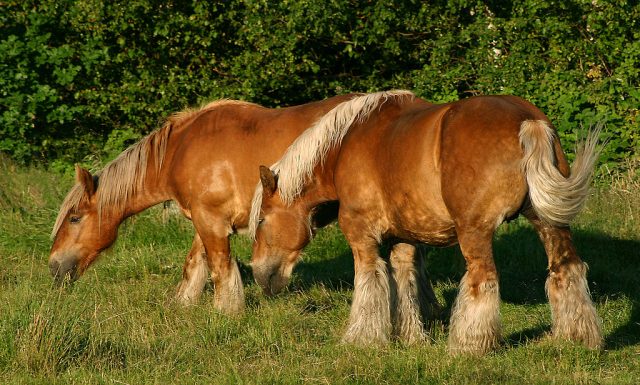Type the name of the breed you're looking for below
[wpdreams_ajaxsearchlite] Don't see the breed your're looking for? Click here and let us know!
Jutland horse
| Country Of Origin | Denmark |
| History and Background | The origins of the breed are not fully documented, but some evidence points to the ancestors of the Jutland being used by the Vikings during the early 9th century. Images from the time show Viking raiders in what is now Great Britain riding horses similar in appearance to the modern Jutland. Some of those horses may have been left behind, contributing to the base stock from which the Suffolk Punch was eventually developed. Horses from Jutland were exported to England, Germany and France during the Middle Ages, and were popular mounts for knights, especially for use in jousting. The first mention of the Jutland type is from the 12th century, when they are documented as war horses with many useful attributes. The Jutland horse appears in the Danish ballad Svend Felding's Kamp med Risen, in which mythic hero Svend Fælling goes on a pilgrimage to Rome and on his journey encounters a giant. Other horses prove too shy or too weak to enable him to confront the giant, therefore Svend obtains a Jutland horse from a passing miller, who claims that it is strong enough to carry fifteen skippund. Mounted on the Jutland, Svend succeeds in killing the giant. The Frederiksborg horse, another Danish breed, influenced the Jutland during the 18th century. The Frederiksborg had a significant amount of Spanish influence, and was used to give the Jutland more active gaits. Selection for the modern-day Jutland appears to have begun around 1850, when Suffolk Punch and Ardennes blood was crossbred on native bloodstock. Cleveland Bay and Yorkshire Coach Horse (a Cleveland Bay/Thoroughbred cross) horses were also added during the 19th century. The development of the breed was significantly influenced by a stallion named Oppenheim LXII, imported into Denmark in 1862. Sources disagree as to whether Oppenheim was a purebred Suffolk Punch or a Suffolk/Shire cross. Six generations from Oppenheim, his descendant, Aldrup Menkedal (spelled Oldrup Munkedal in some sources), was foaled. Aldrup Munkedal is considered the founding stallion of the modern breed. Most Jutlands alive today descend from two of his sons, Hovding and Prins af Jylland. The Jutland strongly resembles the Schleswig, another heavy draft breed with similar origins that was influenced by Oppenheim LXII and his descendants. With the exception of feathering on its lower legs, the Jutland also resembles the Suffolk Punch. The first stud book for the breed was created in 1881, and 22,000 horses were registered between then and 2007. In 1887 the first breeders' association was formed. The first stallions were evaluated according to breed standard in 1888, the same year the Cooperative Jutlandic Breeding Association was created. In 1898, the "Federated Funen Horse Breeding Societies" were established in Funen, dedicated to the development of Jutland horse breeding and other heavy draft horses. By the 1950s, Jutland population numbers exceeded 15,000, and 405 stud farms were devoted to their breeding in Denmark, but since that time, population numbers have dwindled. Though numbers dropped, a 2008 study of the 716 Jutland horses in the Danish studbook at that time concluded that there was little risk of the Jutland becoming extinct due to inbreeding or low genetic diversity. The study, which also included populations of the Knabstrupper and Fredericksborg breeds, theorized that the greatest loss to genetic diversity for horses in Denmark would be through the extinction of the Jutland breed, because of its genetic distance from the other two native breeds. The level of genetic diversity of the three Danish breeds was found to be similar to other European breeds. As of 2011, one Danish breed conservation organization estimates that there are about 1,000 Jutlands. |
| Use Today | Competition horse, Pleasure horse, Riding horse, Work in urban areas |
| Height | 15 to 16 hands high (60-64 inches, 152-163 centimeters) |
| Colour | Bay, Black, Chestnut |
| Characteristics | The breed has a convex facial profile; a short, arched neck; low withers; a wide chest and straight shoulder and a slightly sloped croup. Overall, it is a compact, muscular breed. Although compact in size, the Jutland is a strong, powerful horse that was used to transport carriages and heavy goods. An 1897 publication by the United States Bureau of Foreign Commerce noted the ability of the horse to pull carriages and stated, "For this class of work and for heavy draft generally there is probably no better animal than the Jutland horse—a heavy, powerful beast." |
| Personality and Temperament | Despite their size and strength, Jutland horses are good-natured. Jutland horses have a reputation for being docile, kind and obedient. They are very willing to perform heavy work, making them suitable for hauling heavy cargo or for doing strenuous farm work. |
| Other Considerations | Although originally bred for use on farms, few members of the breed are used for agricultural purposes today, and are now mostly bred for horse shows and working in urban areas. However, the Carlsberg brewery has used the Jutland to pull its drays since 1928. The brewery owned 210 Jutlands at their peak, and today still uses about 20 for transporting beer around Copenhagen. The Carlsberg horses also compete and put on demonstrations at many shows, promoting the brewery and the breed. |



